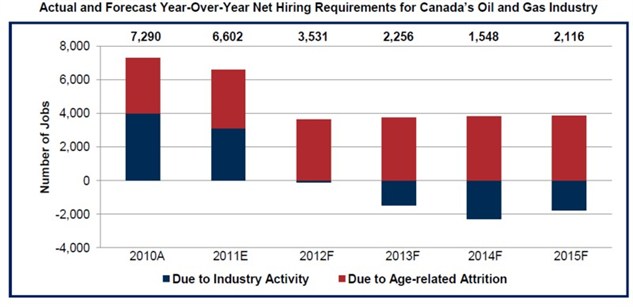Alberta's Oil Sands Operations to Increase Workforce by Over 70 Per Cent
 Canada’s oil and gas industry will need to fill a minimum of 9,500 jobs by 2015, according to a report released today by the Petroleum Human Resources Council of Canada.
Canada’s oil and gas industry will need to fill a minimum of 9,500 jobs by 2015, according to a report released today by the Petroleum Human Resources Council of Canada.Highlights from the report, Canada’s Oil and Gas Labour Market Outlook to 2015, state that between now and 2015, Canada’s oil and gas industry is at risk of losing about three per cent of its workforce overall, because of persistently low natural gas prices. However, two primary factors - growth in certain operations and age-related attrition across the industry - will offset most job losses and in fact contribute to increased overall hiring needs.
Changes in the number of jobs will not be equal across all industry sectors. For example, the oil and gas services sector, although impacted by commodity price volatility, will still need to fill about 5,400 jobs between 2012 and 2015. The exploration and production (E&P) sector, hardest hit by prolonged low natural gas prices, may see some workforce contraction but will also experience skill and experience gaps as it loses workers due to retirements and turnover, especially for industry-specific roles.
By 2015, employment in the oil sands sector is projected to increase by 29 per cent over 2011 levels, or approximately 5,850 jobs. The pipeline sector will add about 530 jobs over the same period. Both sectors will also need to do significant hiring to replace retiring workers and for turnover.
“This is a complex labour story,” commented Cheryl Knight, Executive Director and CEO of the Petroleum HR Council. “Hiring will increase, but total number of jobs will remain relatively flat. Certain sectors and operations will add jobs, while others will lose some positions. And employee turnover is the wild card that could have recruiters working to fill hundreds of additional job openings over the next four years.”
Knight continued: “At a more granular level, we’re seeing high demand for - and reduced supply of - skilled workers in specific occupations, many of which are unique to the oil and gas industry. Retirements are the greatest cause of this growing - and alarming -skill and experience gap. The technical capabilities and knowledge of retiring, experienced workers are just not easily replaced by new entrants.”
Funded in part by Government of Canada’s Sector Council Program and the Province of Alberta. Canada’s Oil and Gas Labour Market Outlook to 2015 includes labour demand projections for 38 core occupations in Canada’s oil and gas industry, within four industry sectors (E&P, oil sands, oil and gas services and pipeline).
Analysis is also provided for key operating regions in Western Canada (British Columbia, Alberta and Saskatchewan) as well as for the rest of Canada. The report is now available for purchase at www.petrohrsc.ca. Alberta’s Oil and Gas Labour Market Outlook to 2015, a companion product, is available for free to those who purchase the Canada-wide outlook.
The Petroleum HR Council’s outlook provides oil sands labour demand projections and analysis based on data for 55 core occupations within three facility/operation types: in situ, mining and upgrading.
For example, employment within in situ operations will experience the greatest growth, driving a number of emerging occupations and an increased reliance on the oil and gas support services workforce. Increased mining and upgrading activities will also contribute to the sector’s employment growth.
“The oil sands sector entered 2012 with a healthy dose of optimism, with all indicators - notably stable oil prices and strong international investment - pointing to continued expansion,” explained Cheryl Knight.
“Demand for more workers is being driven primarily by growth in the sector, however our research tells us that the supply of skilled workers remains very tight. Going forward, age-related attrition and competition from other industries will further escalate labour and skills shortages faced by the sector. In fact, the sector may need to hire 116 per cent of its current employment levels due to industry expansion, retirements and turnover.”
Oil Sands Labour Market Outlook to 2021 also states industry will be challenged to manage workforce costs in this employee-driven labour market. The oil sands sector will have to give considerable thought to effective and efficient strategies to work with the construction, maintenance and oil and gas support services sectors, which are critical to the growth and sustainability of oil sands operations.
A number of business, regulatory, social and other trends are leading to significant structural changes within Canada’s petroleum industry.
Highlights from the Petroleum HR Council Report Canada’s Oil and Gas Labour Market Outlook to 2015 include the following:
•Technology is and will remain industry’s game changer by unlocking untapped oil and gas resources.
•As natural gas prices stay low, Canadian petroleum companies have shifted to more oil and liquids-rich plays.
•Access to new markets in general, and the Asia-Pacific market in particular, is paramount.
•Strong commodity prices only lead to profitability and sustainability when cost-management remains a priority. Industry will be challenged to manage workforce costs in an employee-driven labour market.
•The social license to operate has never been more difficult for the Canadian petroleum industry to obtain.
The business trends identified above are driving some important labour trends in the Canadian oil and gas industry, including:
•The competition for natural resource workers is global. Demographics are putting an additional strain on industry’s recruitment.
Industry volatility and uncertainty, along with domestic and global competition from other resource sectors, will continue to hinder the Canadian petroleum industry’s ability to attract workers.
•Many of the occupations unique to the oil and gas industry will experience the greatest skills shortages.
•Environmental policy and regulations will drive the need for new expertise

Major capital projects for the sector are definitely impacting the future workforce needs for oil sands operations.
Additionally, the report includes summary tables and charts, detailed appendices, executive summary and a concise fact sheet. This study was funded by the Government of Alberta.
You can return to the main Market News page, or press the Back button on your browser.

